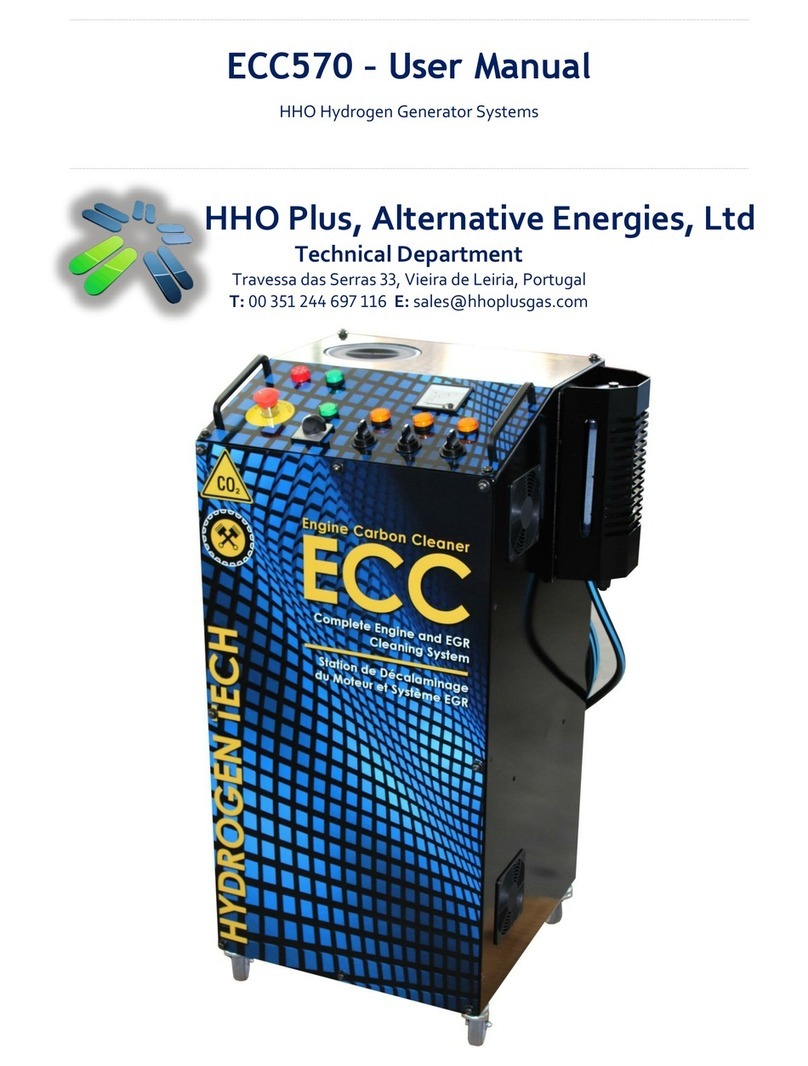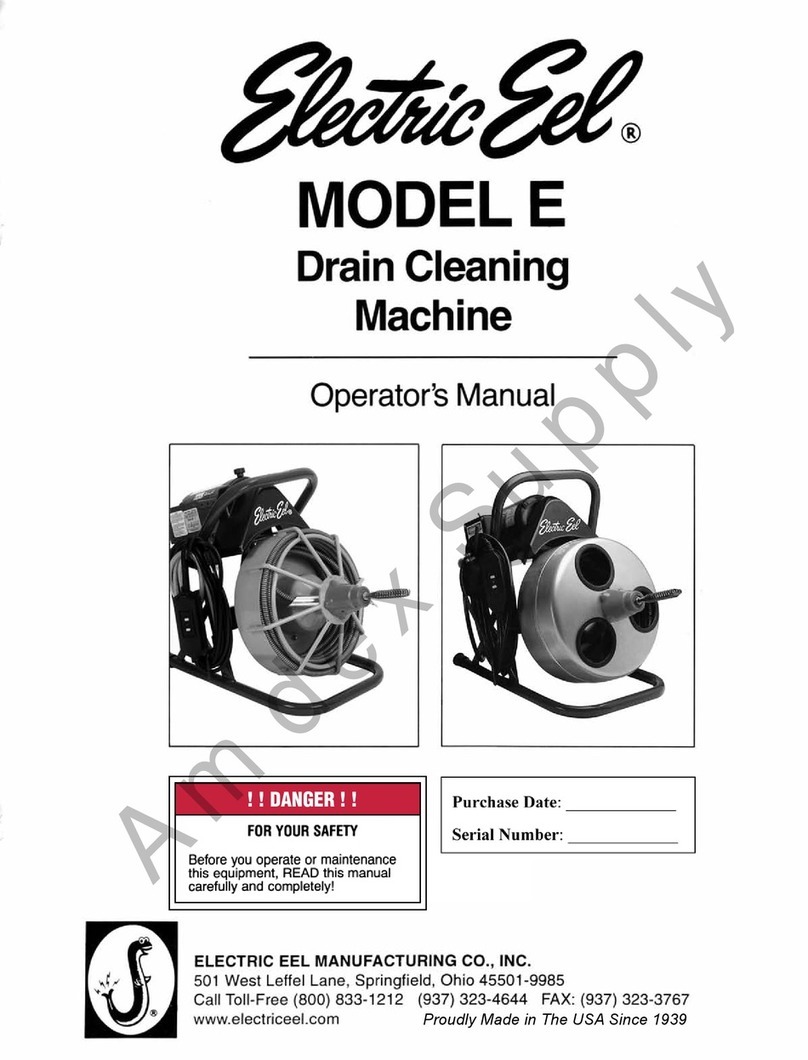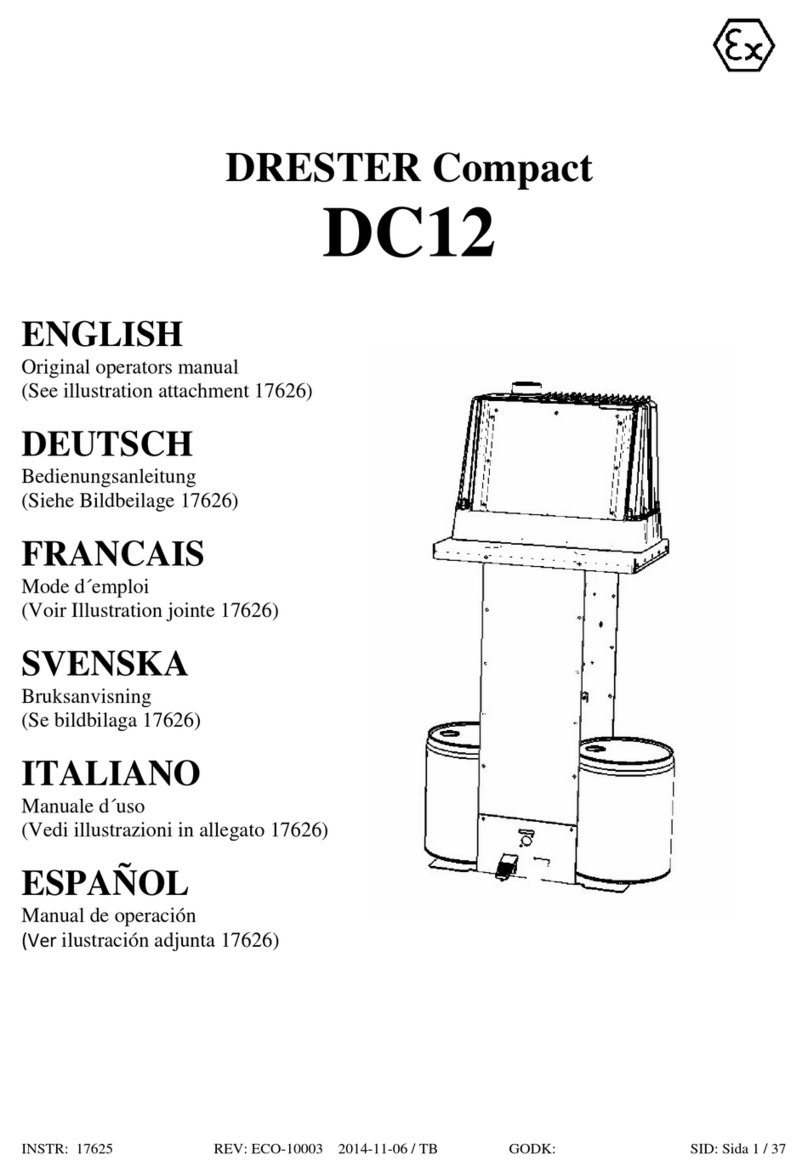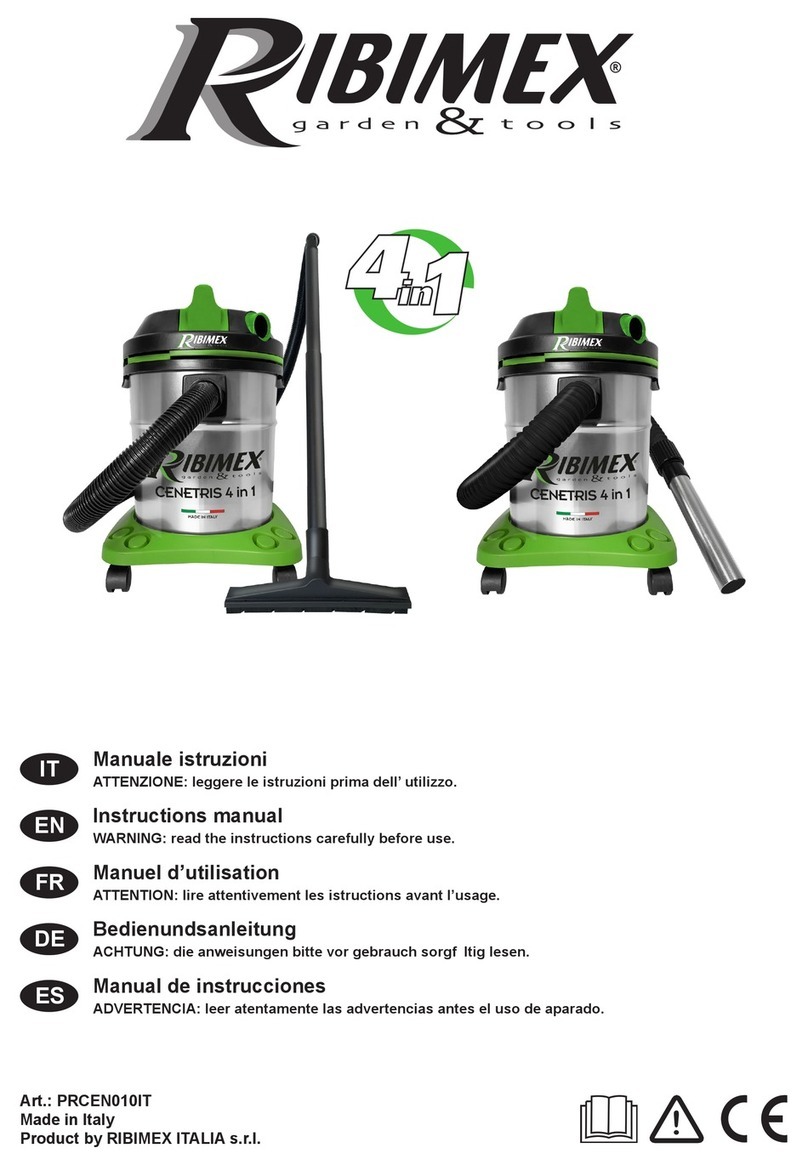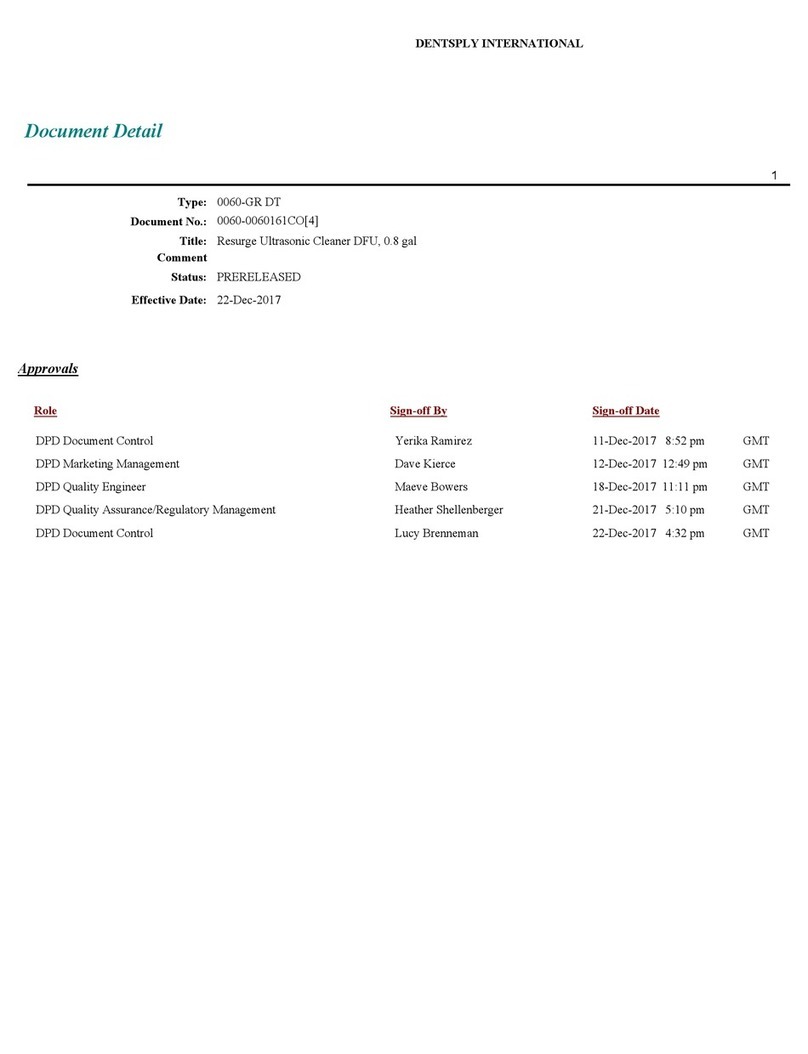HHO Plus ECC230 User manual

ECC230–User Manual
HHO Hydrogen on Demand Dual Fuel Generator Systems
HHO Plus, Alternative Energies, Ltd
Technical Department
Travessa das Serras 33, Vieira de Leiria, Portugal
T: 00 351 244 697 116 E: sales@hhoplusgas.com

ECC230–User Manual 2
HHO Plus, Alternative Energies, Lda –Travessa das Serras 33, Vieira de Leiria, Portugal –Tel. 00 351 244 697 116 –Email: [email protected]
CONTENTS
1. Safety Precautions 3
2. Components of the machine 4
3. Setting up the machine 5
3.1 Filling the main tank for the first time 5
3.2 Refilling the main tank 5
3.3 Security Bubbler 6
4. Working with the machine 7
4.1 General use 7
4.3 Cleaning the air filter box 7
4.3 Working amperage 8
5. Diesel Cars and DPF Filter Cleaning 9
5. Maintenance 10
Regular Maintenance 10
Winter Maintenance 10
Bi-annual Maintenance 10
Technical Information 11
EC Declaration of Conformity 12

ECC230–User Manual 3
HHO Plus, Alternative Energies, Lda –Travessa das Serras 33, Vieira de Leiria, Portugal –Tel. 00 351 244 697 116 –Email: [email protected]
1. Safety Precautions
Read and follow these safety precautions to avoid hazards. Your ECC230 AC machine do not store hydrogen,
subsequently there is no fire hazard when used properly. However water electrolysis generates Hydrogen, a
explosive gas, which means that you should never light a match or smoke near or in front of the end of the
hose - the protection bubbler inside the machine could blow up!
Be sure to wear goggles and rubber gloves and only use professional tools; use common sense and general
safety procedures used for any work carried out on automotive operations and maintenance.
The electrolyte –Potassium hydroxide KOH - should be handled with extreme care because it´s a corrosive
product. Be sure to wear goggles and rubber gloves when adding or removing electrolyte solution from the
machine.

ECC230–User Manual 4
HHO Plus, Alternative Energies, Lda –Travessa das Serras 33, Vieira de Leiria, Portugal –Tel. 00 351 244 697 116 –Email: [email protected]
2. Components of the machine

ECC230–User Manual 5
HHO Plus, Alternative Energies, Lda –Travessa das Serras 33, Vieira de Leiria, Portugal –Tel. 00 351 244 697 116 –Email: [email protected]
3. Setting up the machine
3.1 Filling the main tank for the first time
Please follow these simple steps:
1. Use a plastic container to prepare the electrolyte solution first outside the machine. Be sure to wear goggles
and rubber gloves for security reasons;
2. The electrolyte concentration to use is around 15 grs/liter of water. Add the full package (500 grs) provided
with the machine to 30 liters of water. You can use any type of water but try to avoid water with bad quality
or too many salts (iron or calcium). Tap water will work fine;
3. Connect the battery clamps of the power cable to the terminals of the battery in your car. The lateral fan
and a red light, buzzing and blinking, (Minimum Level) will be turned ON;
4. Open the water tank lid and pure gently the mixture inside the water tank avoiding any spell. As the water
level raises in the tank the red buzzing light will be turned OFF;
5. Continue adding the electrolyte solution until the green steady light is turned ON. When this light appears
please stop adding electrolyte solution;
6. Close the water tank lid making sure it is well tight.
3.2 Refilling the main tank
As you use the machine the water level inside the tank will start to descend. First the green will turn OFF. After
around 100 hours of work the red light will start to buzz and blink. It´s time to refill the machine again with
electrolyte solution
For refilling please follow these simple steps:
1. Use a plastic container to prepare the electrolyte solution first outside the machine. Be sure to wear goggles
and rubber gloves for security reasons;
2. The electrolyte concentration to use is around 5 grs/liter of water. Add around 100 grs of Potassium
Hidroxide 90% pure to 20 liters of good quality water.
4. Open the water tank lid and pour gently the mixture inside the water tank avoiding any spell. As the water
level raises in the tank the red buzzing light will be turned OFF once again;
5. Continue adding the electrolyte solution until the green steady light is turned ON. When this light appears
please stop adding electrolyte solution;

ECC230–User Manual 6
HHO Plus, Alternative Energies, Lda –Travessa das Serras 33, Vieira de Leiria, Portugal –Tel. 00 351 244 697 116 –Email: [email protected]
6. Close the water tank lid making sure it is well tight.
3.3 Security Bubbler
The bubbler is located laterally in the machine and serves two purposes: cleaning the Hydrogen gas and act as
a safety barrier against a flame. If a flame reaches the bubbler and ignites the reduced hydrogen accumulated
at the top of the bubbler but the water column will prevent the flame to reach the main tank where there is
much more hydrogen accumulated.
The bubbler comes already filled with a light acid solution from
factory. The level of this solution should be kept between the 2
marks in the metallic protection. If the level drops below the inferior
mark then you should refill the bubbler.
For refilling the bubbler, please follow these simple steps:
1. The solution to use is a light acid, like vinegar (Ph 3);
2. Open the threaded cap positioned on the top of the bubbler;
3. With a small funnel, pure gently the solution and check at the
same time the level rising inside the lateral hose of the bubbler;
4. Stop pouring when the level reaches the maximum level mark;
5. Close the threaded cap. If necessary add a little bit of Teflon tape
to tight it better.

ECC230–User Manual 7
HHO Plus, Alternative Energies, Lda –Travessa das Serras 33, Vieira de Leiria, Portugal –Tel. 00 351 244 697 116 –Email: [email protected]
4. Working with the machine
4.1 General use
Please follow these simple steps for the general use of the Engine Carbon Cleaner:
1. Open the air filter box, remove filter element and clean the area inside in order to avoid dust particles from
entering the engine;
2. Insert the hose of the machine in the air intake manifold inside the air filter box;
3. Turn engine ON and let it work for some time until it reaches normal working temperature (80-90º);
4. At this point connect the power cable on the back of the machine to the terminals of the battery of the car;
5. Press the first red power control button and check the amperage in the ammeter;
6. Let the engine work idling for the first 20 minutes with only one button working;
7. Every 10 minutes press hard acceleration pedal in order to improve removal of the carbon deposits;
8. After the first 20 minutes of treatment increase the rotations of your engine to 1000 rpm and press second
red power control button. Check again amperage in the ammeter;
9. Keep the machine working for one (1) hour to complete engine cleaning;
10. Every 10 minutes make strong acceleration in order to remove faster carbon deposits.
11. Repeat this operation every 10 000 km.
4.3 Cleaning the air filter box
The system is operated by vacuum suction from your engine's air intake which takes the HHO directly to the
combustion chamber mixing it with the air/fuel. The injection point must be done right after the air filter box
and the MAF/MAP sensor enhancer. Please follow the next steps:
1. Open the air filter box and remove the air filter;
2. In the air filter box please cover the engine air intake
with a cloth to prevent dust particles from entering the
engine;
3. With an air compressor clean the air filter area so that
it stays completely free from dust particles;
4. Remove the cloth and insert the hose in the air intake
manifold.

ECC230–User Manual 8
HHO Plus, Alternative Energies, Lda –Travessa das Serras 33, Vieira de Leiria, Portugal –Tel. 00 351 244 697 116 –Email: [email protected]
4.3 Working amperage
The amperage and hydrogen production will depend on the electrolyte concentration (15 grs/liter of KOH) and
the power of the alternator of the car. Normally there is a relation more or less the same between the engine
size and power of the alternator in all cars. In this way the amperage will vary from car to car depending on
the engine size and alternator.

ECC230–User Manual 9
HHO Plus, Alternative Energies, Lda –Travessa das Serras 33, Vieira de Leiria, Portugal –Tel. 00 351 244 697 116 –Email: [email protected]
5. Diesel Cars and DPF Filter Cleaning
In modern diesel cars it´s always advisable to make the DPF filter diagnosis before the treatment, especially
when the car drives only in towns and it is not possible to make the normal regeneration of the DPF. If the
diesel car has already a problem with the diesel particulate filter (DPF), then it´s likely that the problem could
get more severe with our treatment due to soot coming out of the engine and exhaust system.
If the DPF is clogged then we should clean it using our
engine carbon cleaning machine. We the lines below we
will explain how do this operation.
The main function of the DPF filter is to reduce the
emissions of fine particles (soot) contained in the exhaust
gases. The DPF works in two stages, first he collects the
particles and after it eliminates them:
First step: The filter traps the particles in suspension in the
exhaust gases. A layer of soot then starts forming on the walls of the filter. In long tern this layer of soot will
influence the performance of the engine being necessary to start the regeneration process on the second step.
Second step: When we have the right conditions, the filter force the temperature of the exhaust gases to rise
enough to burn the soot layers. The regeneration process will not work properly when temperatures are low
in winter (for example in Northern Europe) or when the cars only drive in towns or small distances.
When cleaning diesel cars we recommend also the use of the special DXA250 additive
produced for our machines. This additive allow the regeneration of diesel particulate
filters using our engine carbon cleaning machines without removing the DPF. This
additive lowers the ignition temperature of the soot collected in the DPF, optimizing
the regeneration process. The increase of exhaust gases temperature provided by the
combustion of hydrogen during the treatment will allow the right conditions for the
regeneration of the FAP.
This additive can be used as a preventive treatment or as a repair treatment if the DPF
filter is very clogged. Preventive treatment should take place in countries where
temperatures are low in winter (for example in Northern Europe) or when the cars only
run in cities and small distances.
Dosage: We add a bottle (250 ml) of the additive in 20 liters of fuel just before starting
the treatment with our machine.
Duration: 2 hours
Engine revolutions during treatment: Engine at 1000 rpm for one and after one hour at 2500 rpm.

ECC230–User Manual 10
HHO Plus, Alternative Energies, Lda –Travessa das Serras 33, Vieira de Leiria, Portugal –Tel. 00 351 244 697 116 –Email: [email protected]
5. Maintenance
Regular Maintenance
Depending on the weekly working hours, you should check the water level inside the water tank. If the level is
too low, refill the tank with electrolyte solution to allow amperage to be at normal operational values.
Winter Maintenance
If temperatures drop below -4ºC then you should add 20-25% isopropyl alcohol to the water solution in order
to avoid water from freezing, even with the more severe temperatures. Don´t use another type of alcohol or
you risk damaging the stainless steel plates.
Bi-annual Maintenance
Depending on the working hours of the machine, you should clean the machine and remove all deposits every
six months. Please follow these simple steps:
1. Add 50% isopropyl alcohol to the water solution and leave it in the machine without working for 24 hours;
2. Next day start the machine and let it work for 20 minutes;
3. Stop the machine and open the frontal panel. Inside the machine you will find 2 valves to help you flush the
water;
4. Once all water is out, please close the valves a add fresh water until you reach the maximum water level in
the tank;
5. Open the 2 valves again and let it flush all the liquid inside the machine;
6. Close the valves and put in place the frontal panel;
7. Repeat all steps mentioned in point 3.1.

ECC230–User Manual 11
HHO Plus, Alternative Energies, Lda –Travessa das Serras 33, Vieira de Leiria, Portugal –Tel. 00 351 244 697 116 –Email: [email protected]
Technical Information
Voltage: 230V AC
Max Power: 1200 kW
HHO Gas Output Max: 800 l/h
Max. Pressure (kg/cm2): 0,2
Max. Water Consumption (L/h): 0,20
Water refilling: manual
Water Tank Capacity: 20 liters
Autonomy: 100 hours
Dimensions - L x l x h (mm): 400 x 500 x 700 mm
Weight: 35 kg
Warranty: 24 months

ECC230–User Manual 12
HHO Plus, Alternative Energies, Lda –Travessa das Serras 33, Vieira de Leiria, Portugal –Tel. 00 351 244 697 116 –Email: [email protected]
EC Declaration of Conformity

ECC230–User Manual 13
HHO Plus, Alternative Energies, Lda –Travessa das Serras 33, Vieira de Leiria, Portugal –Tel. 00 351 244 697 116 –Email: sales@hhhoplusgas.com
HHO Plus
HHO Plus, Energias Alternativas, Lda
VAT Id. Number: PT 509 055 036
Headquarters:
Travessa das Serras 33
2430 - 720 Vieira de Leiria
Portugal
Production Plant:
Zona Industrial de Vieira de Leiria
Rua Manuel Joaquim Afonso Lote 10
2430 - 837 Vieira de Leiria
Portugal
Email: sales@hhoplusgas.com
Telephone: 00 351 244 697 116
Table of contents
Other HHO Plus Ultrasonic Jewelry Cleaner manuals
Popular Ultrasonic Jewelry Cleaner manuals by other brands
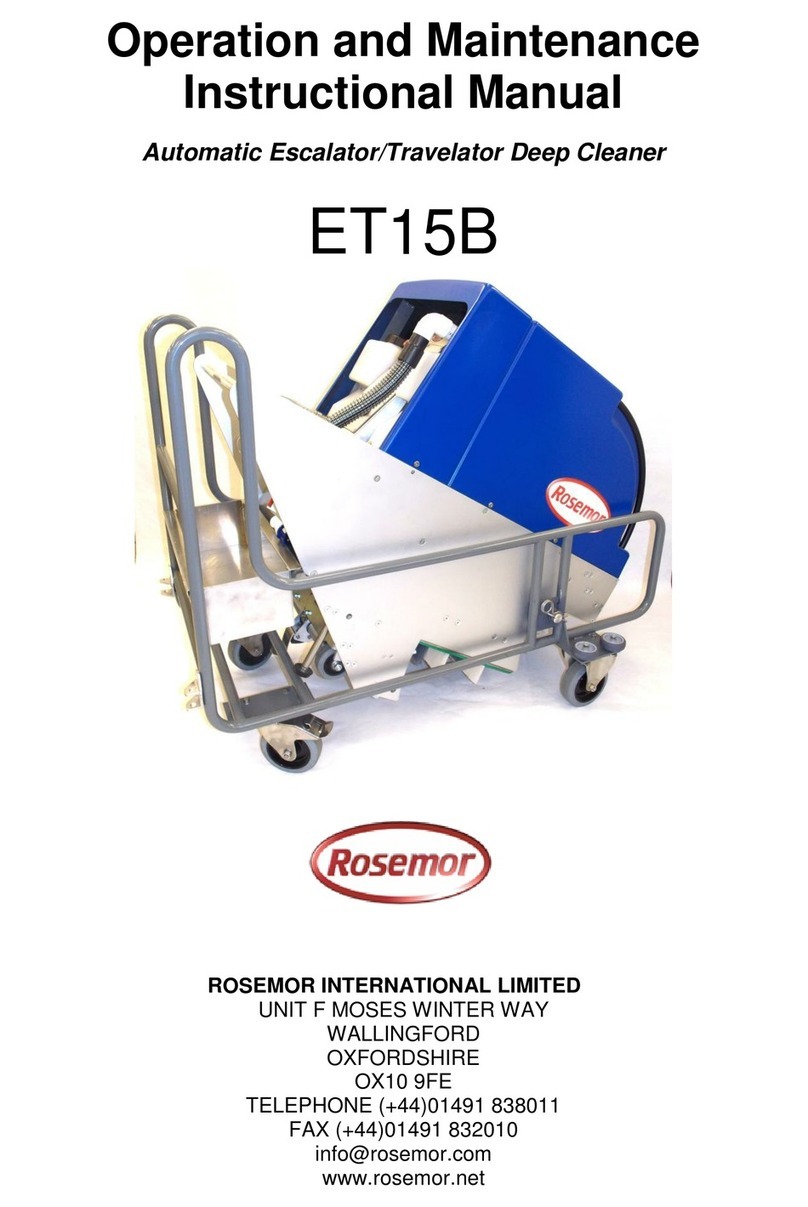
Rosemor
Rosemor ET15B Operation and Maintenance Instructional Manual

RCBS
RCBS ULTRASONIC CASE CLEANER-2 Product instructions
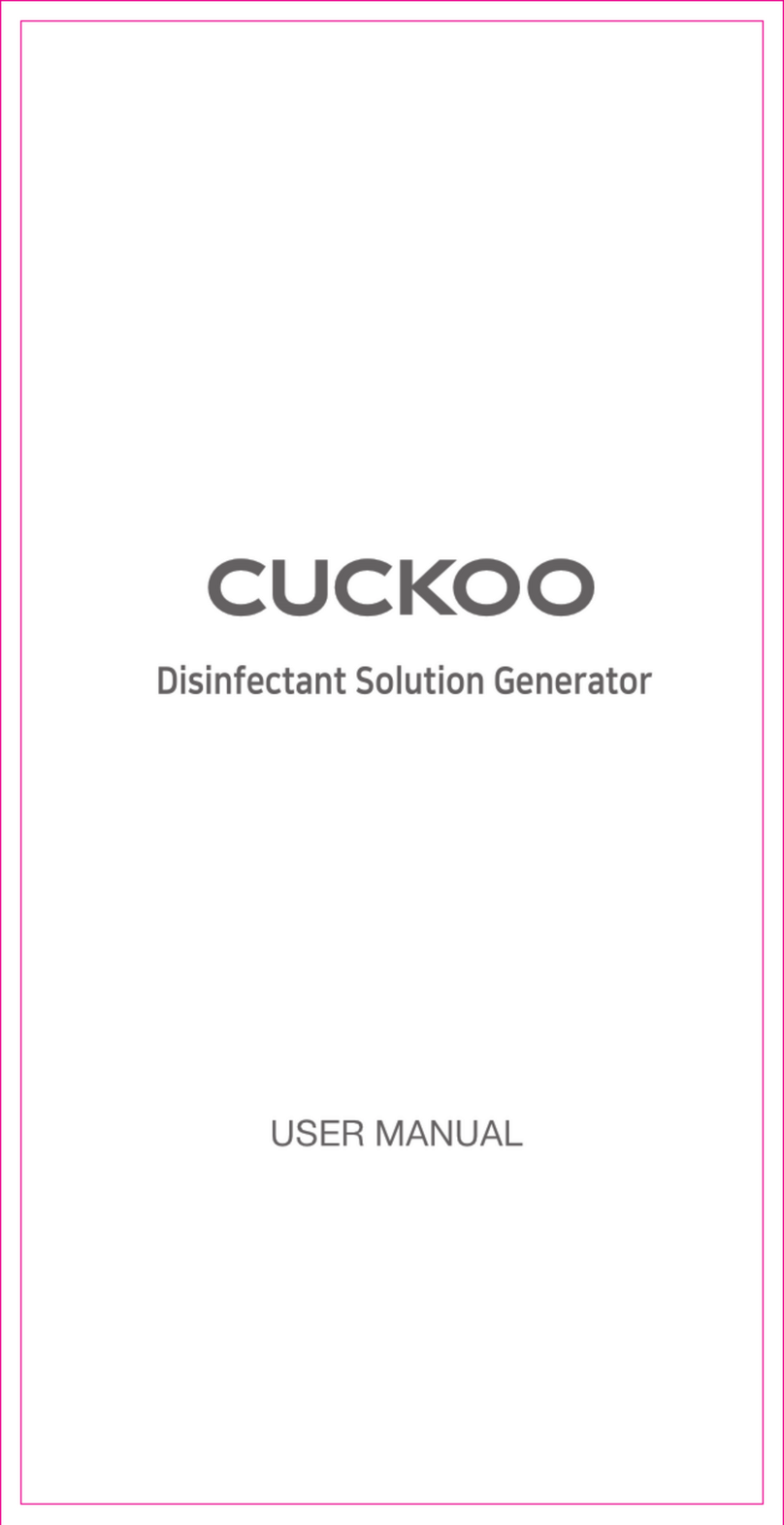
Cuckoo
Cuckoo CS-A0250AW user manual

Makita
Makita BCL140 instruction manual
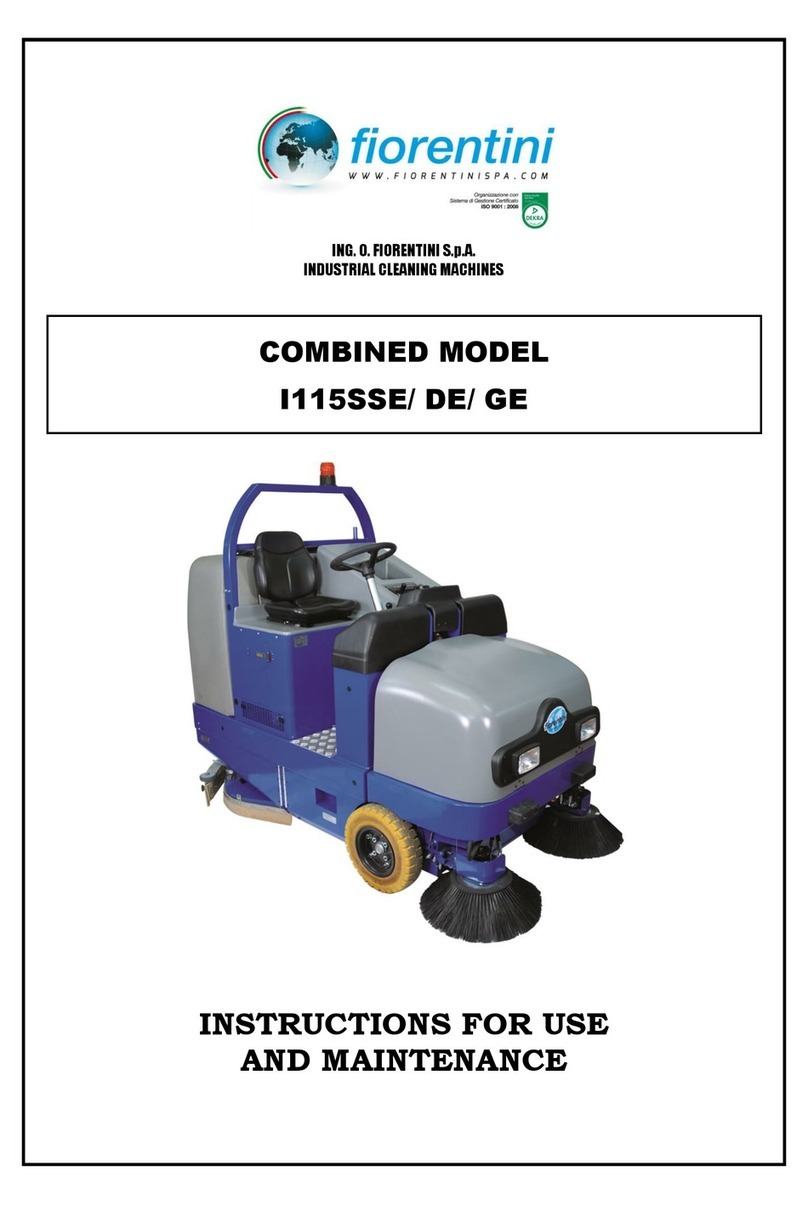
FIORENTINI
FIORENTINI I115SSDE Instructions for use and maintenance
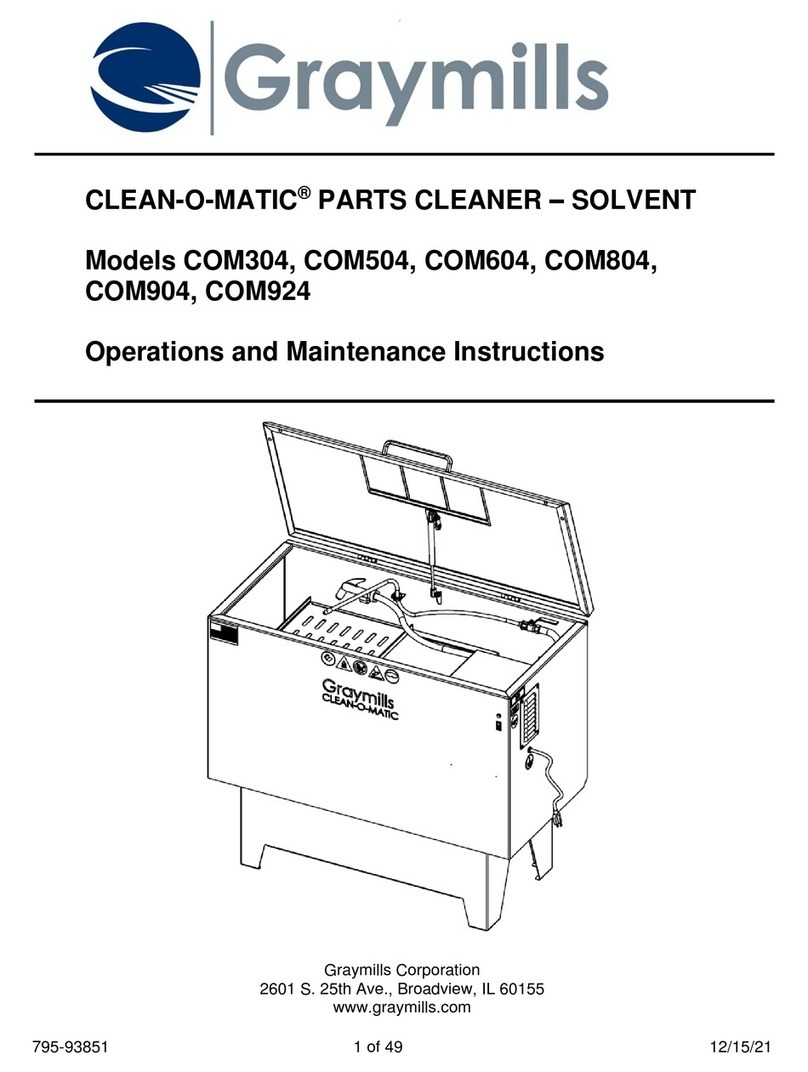
Graymills
Graymills CLEAN-O-MATIC COM304 Operation and maintenance instructions

General
General Sewerooter T-3 operating instructions
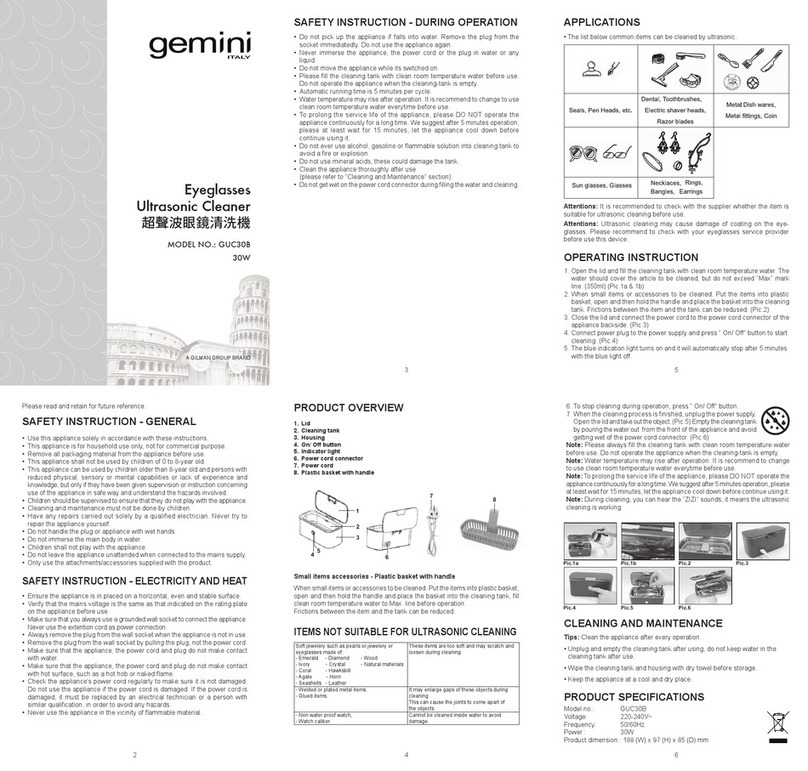
GILMAN
GILMAN gemini GUC30B quick start guide

Xtreme Power
Xtreme Power 45096 Owner's manual and safety instructions

James products
James products ULTRA 8051 user manual

Kärcher
Kärcher WV 50 operating instructions
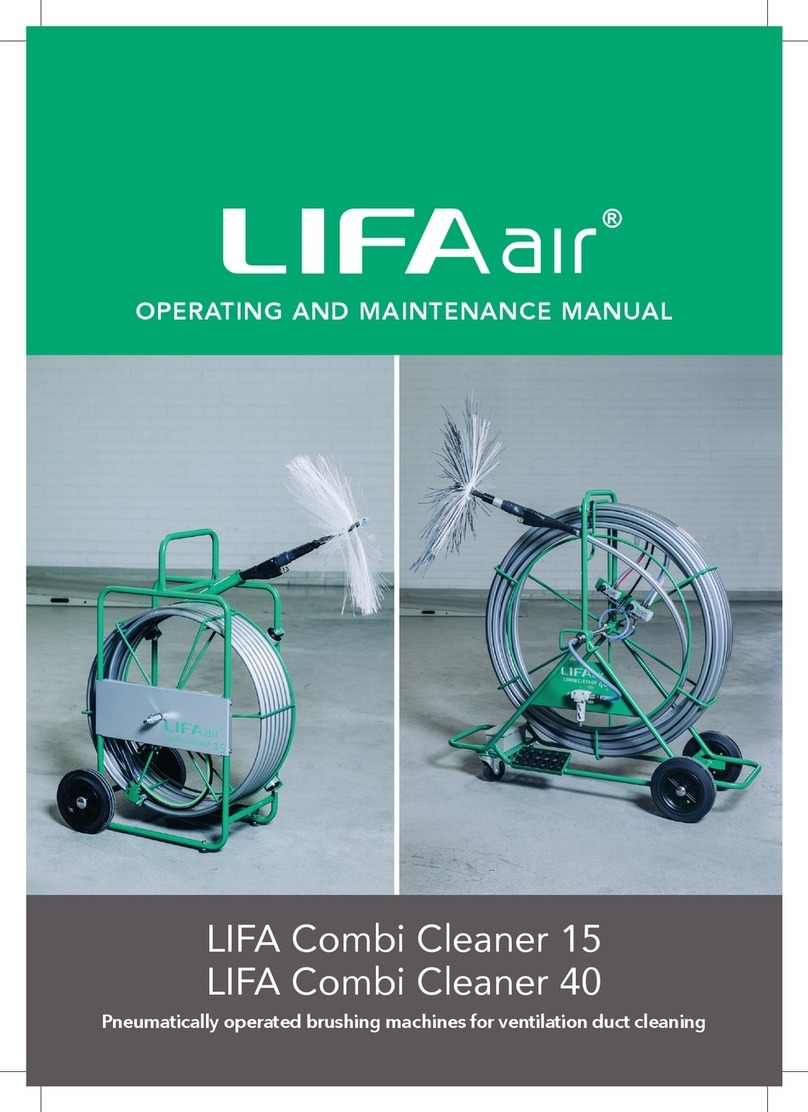
Lifa Air
Lifa Air Combi Cleaner 15 Operating and maintenance manual


